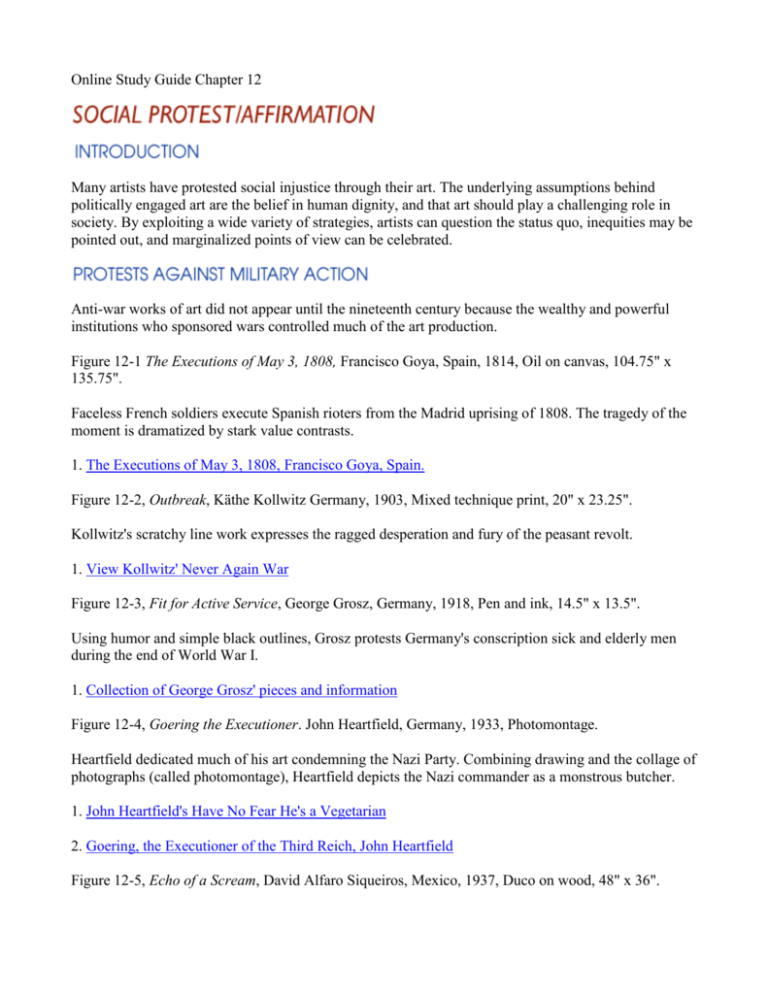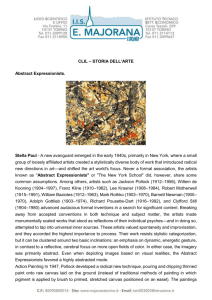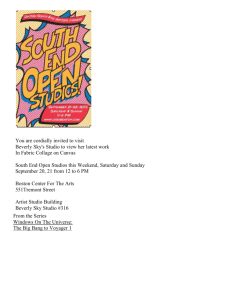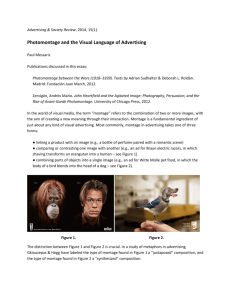0495094870_257850
advertisement

Online Study Guide Chapter 12 Many artists have protested social injustice through their art. The underlying assumptions behind politically engaged art are the belief in human dignity, and that art should play a challenging role in society. By exploiting a wide variety of strategies, artists can question the status quo, inequities may be pointed out, and marginalized points of view can be celebrated. Anti-war works of art did not appear until the nineteenth century because the wealthy and powerful institutions who sponsored wars controlled much of the art production. Figure 12-1 The Executions of May 3, 1808, Francisco Goya, Spain, 1814, Oil on canvas, 104.75" x 135.75". Faceless French soldiers execute Spanish rioters from the Madrid uprising of 1808. The tragedy of the moment is dramatized by stark value contrasts. 1. The Executions of May 3, 1808, Francisco Goya, Spain. Figure 12-2, Outbreak, Käthe Kollwitz Germany, 1903, Mixed technique print, 20" x 23.25". Kollwitz's scratchy line work expresses the ragged desperation and fury of the peasant revolt. 1. View Kollwitz' Never Again War Figure 12-3, Fit for Active Service, George Grosz, Germany, 1918, Pen and ink, 14.5" x 13.5". Using humor and simple black outlines, Grosz protests Germany's conscription sick and elderly men during the end of World War I. 1. Collection of George Grosz' pieces and information Figure 12-4, Goering the Executioner. John Heartfield, Germany, 1933, Photomontage. Heartfield dedicated much of his art condemning the Nazi Party. Combining drawing and the collage of photographs (called photomontage), Heartfield depicts the Nazi commander as a monstrous butcher. 1. John Heartfield's Have No Fear He's a Vegetarian 2. Goering, the Executioner of the Third Reich, John Heartfield Figure 12-5, Echo of a Scream, David Alfaro Siqueiros, Mexico, 1937, Duco on wood, 48" x 36". The horrors of warfare echo into the face of a screaming child. Siqueiros was protesting the Spanish Civil War. 1. Echo of a Scream, David Alfaro Siqueiros See Pablo Picasso's Guernica (Figure 11.26) for another artwork that deals with the Spanish Civil War. 1. Picasso's Guernica, at the Reina Sophia Museum 2. Detail from Picasso's Guernica and information about the Spanish Civil War Figure 12-6, Elegy to the Spanish Republic XXXIV, Robert Motherwell, U.S.A., 1953-1954, Oil on canvas, 80" x 100". Motherwell believed that universal human themes and emotions could be communicated through abstract form. He painted over 150 works relating to the defeat of the Spanish Republic in the Spanish Civil War. 1. Elegy to the Spanish Republic XXXIV, Robert Motherwell Figure 12-7, Woman with Keloidal Scars, Tomatsu Shomei, from the series 11:02 — Nagasaki, Japan, 1966, Gelatin silver print, 11.5" x 16". Shomei photographed the devastating emotional and physical scars left by the atomic bomb dropped on Nagasaki during the Second World War. 1. Tomatsu Shomei Online 2. Tomatsu Shomei's Skin of the Nation Figure 12-8, Mercenaries I, Leon Golub, U.S.A., 1976, Acrylic on canvas, 116" x 186.5". The repeated scraping of the paint surface enhances the visceral brutality of Golub's portrayals of mercenaries and torture scenes. 1. Leon Golub, Mercenaries IV 2. Leon Golub, Vietnam II Artists fighting for the rights of the economically or politically oppressed can use beauty, illustration, narrative, humor, or shock tactics to get their point across. Figure 12-9, Liberty Leading the People, Eugene Delacroix, France, 1830, Oil on canvas, approximately 8'6" x 10'8". Delacroix mixes romanticism, idealism, and realism about revolution in his painting of Liberty leading the 1830 Paris revolt against the monarchy. Liberty is presented as a half-clothed woman, part goddess, part modern French woman. 1. Liberty Leading the People, Eugene Delacroix Figure 12-10, Leo, 48 Inches High, 8 Years Old, Picks Up Bobbins At 15¢ A Day, Lewis Hine, U.S.A., 1910. Hine used photography to illustrate the harsh conditions of child labor in sweatshops. His work helped to institute child labor laws in the United States. 2. View an exhibit entitled"Before their Time: Child Labor Through the Lens of Lewis Hine" 3. Self-Portrait with Newsboy by Lewis Hine Figure 12-11, The Passion of Sacco and Vanzetti, Ben Shahn, U.S.A. (born Lithuania), 1931-1932, Tempera on canvas, 84.5" x 48". The three commissioners who upheld the conviction of two labor activists for robbery and murder impassively stand over the dead bodies of men widely believed to have been wrongly accused. 1. The Passion of Sacco and Vanzetti by Ben Shahn Figure 12-12, No. 36: During The Truce Toussaint Is Deceived And Arrested By LeClerc. LeClerc Led Toussaint To Believe He Was Sincere, Believing That When Toussaint Was Out Of The Way, the Blacks Would Surrender, Jacob Lawrence, U.S.A., 1937-1938, Tempera on paper, 11" x 19". From a series of forty-one paintings narrating the life of a Haitian slave leader, Lawrence executed the paintings with simple shapes and a flat, subdued palette. 1. View"Jacob Lawrence: The Toussaint L'Ouverture Series" Lawrence trained in Harlem during the Harlem Renaissance and was influenced by the vibrant community of artists, writers, and performers, as shown in Faith Ringgold's The Bitter Nest, Part II: The Harlem Renaissance Party (Fig. 3.48). And example of a Cubist work is Pablo Picasso's Guernica (Fig. 11.26) Figure 12-13, The Rent Collection Courtyard (detail), anonymous team of sculptors (Ye Yushan and a team of sculptors from the Sichuan Academy of Fine Arts, Chongqing.), Dayi, Sichuan, China, 1965, Clay, life-size figures. A peasant pays taxes to an imperious landlord. These sculptures were commissioned by the Communist government to validate the land redistribution program they introduced in the 1950's. (See also figure 5.7) 1. The Rent Collection Courtyard Contrast the idea of the anonymous artist working at the service of others with the notion of art stars and the artist as genius in Chapter 5, Who Makes Art? The Rent Collection Courtyard is similar to the USA marine Corps War Memorial in Figure 11.27 (page 297), in that both are highly realistic, both memorialize past events, and both essentially affirm the existing government of each nation. They do, however, commemorate different kinds of events. Figure 12-14, The State Hospital, Edward Kienholz, U.S.A., 1966, Mixed media, 8' x 12' x 10'. Kienholz nightmarishly recreates the cruel isolation of a mental patient tied to a bed inside a dank cell. Shock tactics can be a powerful tool in expressing social wrongs. 1. Explore the work of Edward Kienholz at this site, with links to many of his works Figure 12-15, Insertions into Ideological Circuits: Coca-Cola Project, Cildo Meireles, Brazil, 1970, Screenprinting on Coca-Cola bottles. Phrases like"yankee, go home!" were silkscreened onto Coca-Cola bottles to promote an economically independent Brazil. 1. Insertions into Ideological circuits: Coca-Cola Project by Cildo Meireles 2. Insertions into Ideological Circuits: Bank-note Project (Who Killed Herzog?) by Cildo Meireles Some would say that writing"Yankees go home!" on Coca-Cola bottles is not art. Others would argue that an artist's job is to increase the viewer's awareness. For more, see Chapter 4, Deriving Meaning. Figure 12-16, Sun Mad, Ester Hernandez, U.S.A., 1981, Color serigraph, 22" x 17". Hernandez protests the use of deadly pesticides by grape growers. The packaging of a well-known raisin brand is altered to deliver a fast and hard-hitting punchline. 1. Sun Mad by Ester Hernandez 2. View La Pelona by Ester Hernandez 12-17, Yinka Shonibare, Mr. and Mrs. Andrews Without Their Heads, 1998. Wax-print cotton costumes on mannequins, dog mannequin, painted metal bench and rifles, 65" x 224" x 100". Courtesy Stephen Friedman Gallery, London. Collection of the National Gallery of Canada, Ottawa. 1. View Mr. and Mrs. Andrews Without Their Heads. Figure 12-18, Kara Walker. “They Waz Nice Folks While They Lasted" (Says One Gal to Another). Installation view. Cut paper silhouettes and light projections. USA, 2001. Courtesy Brent Sikkema, New York. 1. Kara Walker Online Shonibare based his sculpture on the eighteenth-century painting by British artist Thomas Gainsborough, Mr. And Mrs. Andrews (Fig. 2.10). Affirming the Values of the Oppressed When people are oppressed, their way of life and values tend to be discounted and ridiculed. Art is an effective tool to protest unjust oppression and affirm the lifestyles of the downtrodden. Figure 12-19, Ambrogio Lorenzetti. Allegory of Good Government: The Effects of Good Government in the City and in the Country (detail). Fresco. Italy, 1338-1339. Sala della Pace, Palazzo Publico, Siena, Italy. 1. View the entire painting at this site. Figure 12-20, Hans Holben The Younger, Sir Thomas More, Flanders, 1527. Oil on oak panel, 29 ½” x 23 ¾”. Frick Collection, New York. 1. Hans Holbein The Younger Online Like the Australian Aboriginal artists, many contemporary Native American artists continue to reference traditional imagery and art processes in the work they produce today, as in the late-twentieth-century Bowl by Maria Martinez (see Fig. 3.41). Figure 12-21, Codex Borbonicus, early 16th century. Detail depicting Quetzalcoatl and Texcatlipoca. Paint on vellum, 39cm x 40cm. Aztec. 1. Codex Borbonicus Figure 12-22, The Aboriginal Memorial, Paddy Dhatangu, David Malangi, George Milpurrurru, Jimmy Wululu, and other artists from Ramingining, Australia, 1988, Natural pigments on 200 logs, Heights: 16" to 128". Installation view of upright Aboriginal coffins. Aboriginal history is memorialized in this collaborative installation. Each log/coffin represented each year of European occupation in Australia. A nationwide celebration of the British"discovery" of the continent is reinterpreted as a day of mourning. 1. The Aboriginal Memorial Figure 12-23, Pepon Osorio. The Scene of the Crime (Whose Crime?). Mixed media installation, dimensions variable. Puerto Rico/USA, 1993-1999. Bronx Museum of the Arts. Purchased through funds from the H.W. Wilson Foundation and the National Endowment for the Arts, 1999.1.4. 1. View a clip from The Scene of the Crime. Figure 12-24, Mona Hatoum. Light Sentence. Mixed media, dimensions variable. Palestine/England, 1992. Musee National d'Art Moderne, Centre Georges Pompidou. © Courtesy the artist and Jay Jopling / White Cube (London). 1. Mona Hatoum Online Artists often question the status quo. By examining the myths, assumptions, and underlying systems of power operating within a society, artists hope to open up different possibilities in the way we see and act. The Social Environment Figure 12-25, Breakfast Scene, William Hogarth, from the series Marriage à la Mode, England, c. 1745, Oil on canvas, 28" x 36". The extravagance and dissolute lifestyle of the upper classes was a popular target of ridicule in Hogarth's art. 1. Breakfast Scene, from the series Marriage a la Mode, by William Hogarth 2. View scene from Hogarth's The Rake's Progress Figure 12-26, Backs, Magdalena Abakanowicz, Poland, 1976-1982, 80 pieces, burlap and glue, each over-life-size. Human backs without appendages serve as a monument to both dehumanizing conformity and also to human survival. 1. Backs, Magdalena Abakanowicz Figure 12-27, Untitled (Selected Writings), Jenny Holzer, Installation view at the Solomon R. Guggenheim Museum, U.S.A., 1989, Extended helical LED electronic signboard with selected writings, 17 Indian Red granite benches. Simultaneously true and absurd sayings spiral around the interior of the Guggenheim Museum on electronic signboards. Museum visitors reading these sayings are forced to question their own assumptions. 1. View an article, with additional images, about Jenny Holzer from Ohio University Art vs. Politics Figure 12-28, Honore Daumier. The Legislative Belly, France, 1834. Lithograph; image: 11” x 17”; sheet: 13 11/16” x 20 3/16”. Bibliotheque nationale de France, Paris. 1. The Legislative Belly Figure 12-29, Portrait of George, Robert Arneson, U.S.A., 1981, Glazed ceramic, 94" x 29" x 29". Arneson's irreverent and politically charged bust of the slain San Francisco mayor was removed from its intended permanent public display at Moscone Center. (See also figure 5.25) 1. Robert Arneson Online Another artwork that protests against apartheid in South Africa is Hans Haacke's MetroMobiltan in Figure 4.7 (page 90). Figure 12-30, William Kentridge. Drawing from Mine, South Africa, 1991. Mine is a 5 min. 49 sec. Film. Charcoal. 1. William Kentridge Online Figure 12-31, The Knot, Miguel Antonio Bonilla. El Salvador, 1984. Oil on Canvas. Intertwined forces of an oppressive regime, the state and the police, are the targets of The Knot's grim and crude humor. 1. The Museum of Latin American Art








